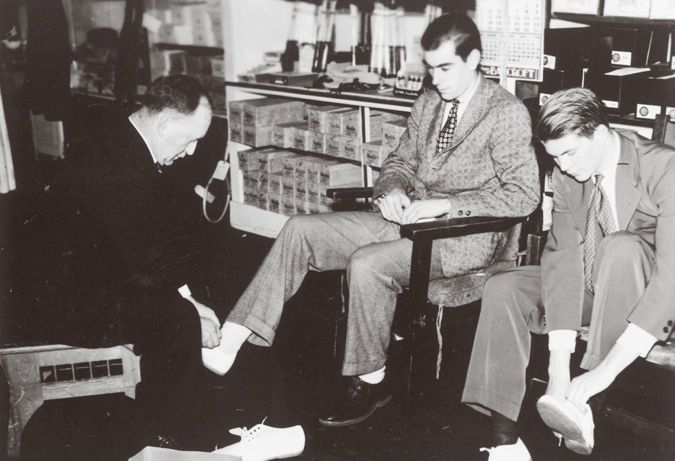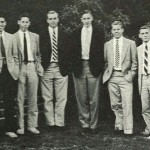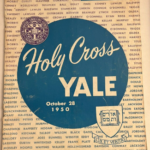The 1930s was the time of the Great Depression, yet simultaneously it was also the golden age of Hollywood glamor and of masculine elegance. It was also the time when the Ivy League Look flourished, though within closed corridors, the aristocratic golden age versus the postwar, democratic silver age.
This article from the Yale Alumni Magazine details what life was like for New Haven students while others were fleeing the Dust Bowl. There was homework, but there was also football games, junior proms, and shopping for white bucks, as shown in the photo above.
Here’s an excerpt:
Life at Yale for wealthy undergraduates resembled escapist movies about the rich and carefree. They enjoyed their automobiles, weekends in New York, country club summers, sailing on Martha’s Vineyard, and trips to Europe. Spectator yachts lined the Thames when Yale rowed against Harvard at New London in June.
When the residential colleges opened in September 1933, undergraduates selected by the college masters (there was not room for all) lived in luxurious suites, ordered meals from printed menus and were served by uniformed waitresses, and after eating perhaps repaired to the squash courts for exercise fitting their station in life. Faculty fellows of the colleges delighted in weekly dinners followed by port, conversation, and sometimes bridge or poker. The residential faculty fellows (bachelors only) had large apartments. The masters lived with their families in mansions worthy of bank presidents before the fall.
Varsity football prospered. Games filled the Yale Bowl with cheering students and alumni. Gate receipts held up so well during the Depression that in 1931, the chair of President Herbert Hoover’s committee for unemployment relief asked Yale to hold a postseason benefit game with other elite schools. In 1937, Yale raised the salary of one part-time assistant football coach, law student Gerald R. Ford ’41LLB, from $3,000 to $3,500, more than that of an entering junior faculty instructor with a PhD.
Some alumni recalled afterwards that they were oblivious to conditions outside of Yale. Hear Senator William Proxmire ’38: “We lived in a kind of disembodied cocoon, a deliberate isolation from what we could see and smell and hear when we left the New Haven Campus. . . . Most of my classmates were wholly preoccupied with sports and girls and grades, and bull sessions about sports and girls and grades—in that order. If you wanted to be happy, it was a great time to be a Yalie. If you wanted to be serious—you had to wait.”
Surely this was the real heyday? — CC & CS











OK, who’s been wearing their white bucks this month?
1936 was the first year that Harvard had more applications for admission to the freshman class than it had spaces in the class. For the fifty years before then, when the Greek requirement in prep or high school was dropped, almost anyone with a high school education that could pay the tuition was accepted. So even then, it was not at all competitive and it can be said that hedonism ruled.
This likely was the real heyday!
I remember the admissions director for Amherst during the Great Depression describing the entrance requirements: The body had to be warm, and the check had to be good.
“Surely this was the real heyday”?
Absolutly yes.
If you was white,wealthy ( in USA possibly also Anglo-Saxon),and obviously in good health,was simply the heaven (New Heaven).
For middle-lower class heaven was twenty years later..but was a crowed heaven.
White bucks retired until spring. Yes, one can wear them whenever, but not yours truly..
“In 1937, Yale raised the salary of one part-time assistant football coach, law student Gerald R. Ford ’41LLB, from $3,000 to $3,500, more than that of an entering junior faculty instructor with a PhD.”
FYI, $3,500 in 1937, adjusted for inflation, was $58,000 in today’s dollars.